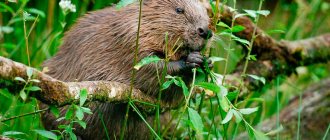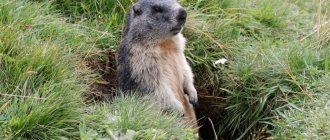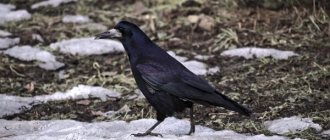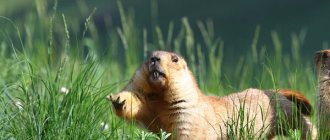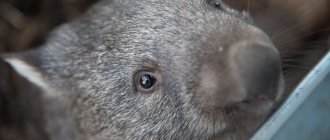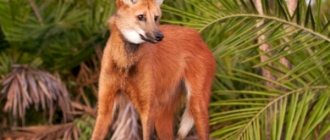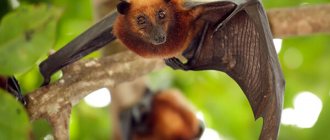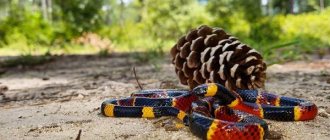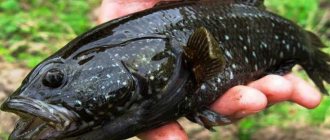- Wild animals
- >>
- Mammals
The marmot is a mammal that belongs to the order of rodents from the squirrel family. Representatives of the species weigh several kilograms and live in open spaces. Extremely social herbivores, wrapping themselves in warm fur and hiding in burrows from the hot steppes to the cold mountains. There are many classifications of these cute animals, which will be discussed further.
Origin of the species and description
Determining the origins of marmots has been a challenge for scientists, but they have been able to solve the mystery through analysis of fossil records and modern equipment.
At the moment, there are the following common types of marmots:
- Bobak group: gray, Mongolian, living in the steppe and forest-steppe;
- Gray-haired;
- Black-capped;
- Yellowbellied;
- Tibetan;
- Alpine subspecies: broad-faced and nominative;
- Talas (Menzbir's marmot);
- Woodchuck - has 9 subspecies;
- Olympic (Olympic).
These species belong to the order of rodents, of which there are more than two hundred thousand, which cover the entire territory of the planet, except for some islands and Antarctica. It is believed that rodents arose about 60-70 million years ago, but some argue that they originated as early as the Cretaceous period.
About 40 million years ago, the ancient ancestor of marmots arose at the beginning of the Oligocene, after an evolutionary leap and the emergence of new families. It is assumed that marmots are the closest relatives of squirrels, prairie dogs and various flying squirrels. At this time they had a primitive structure of teeth and limbs, but the perfection of the design of the middle ear speaks of the importance of hearing, which has survived to this day.
Knowledge of the behavior of marmots and their habits is absolutely necessary when hunting them and obtaining them for resettlement in new places and, what is especially important now, to ensure the possibility of preserving these valuable animals.
The ecological characteristics of representatives of the genus of marmots, which includes more than 10 species - living in burrows in an open landscape, hibernation, family-colonial structure of settlements, relatively late sexual maturity, diurnal activity and limited mobility - are closely related to the morphology of these, the largest after beavers, rodents of the fauna of the USSR and, naturally, find their expression in their behavior, adapted to the conditions and way of life.
Marmots resting at their holes - 1, 2
The huge range of marmots, stretching only in Eurasia from the Pyrenees to the Khingan and from Kamchatka to the Himalayas, would seem to indicate the diversity of their habitats. However, within the range the animals are distributed mosaically and with large gaps, populating various variants of zonal and mountain steppes and meadows. They are very demanding in their choice of habitats—there must be visual and audio communication between the animals, food in the form of long-growing succulent plants, and, finally, fine-earth soil for digging deep holes during hibernation. There are some exceptions to this rule, but they are not numerous. Thus, forest-steppe marmots near Novosibirsk or gray marmots in the Tien Shan often settle in sparse forest or tall grass, limiting the view of the surrounding area. But in such cases, the animals create very high marmots and place holes in their habitat in such a way that they have a good outlook. When mountain marmots settle on glacial moraines or among large stone placers, they always set up observation points at the top of towering rock fragments. These examples show how important it is for animals to observe each other in order to notice and prevent danger in time.
Settling in places with grass that stops growing early, as, for example, in the dry steppes of Kazakhstan, boibaks go into hibernation early and greatly reduce the total duration of ground activity. Females of the Kazakhstan bobak, according to the observations of I.G. Shubin, give birth to cubs very early, before their first spring appearance on the surface, when the weather is unstable and there is little food. Therefore, by the time the marmots emerge, the steppe is vegetating luxuriantly, which allows the marmots to grow and accumulate enough fat in a short time to survive the winter. On the contrary, in the highlands, gray, red and Menzbier marmots, which are also often deprived of adequate food in the spring due to the late growing season of grasses, changed their feeding preferences and adapted to widely use underground parts of plants. In passing, we note that under these conditions, soaked rhizomes often form the basis of the litter in the nesting chambers. In both cases, we find confirmation of the conclusion about the great lability of animal behavior, allowing them to adapt to specific habitat conditions.
A calmly moving marmot - 3. An alert marmot - 4.
Very curious are the habits of the black-capped marmot in the lower reaches of the Lena River, which is forced to spend the winter in shallow burrows (up to 1 m) due to the shallow permafrost. V.I. Kapitonov described a number of ecological and behavioral adaptations to such unusual conditions - the construction of earthen embankments over the nesting chamber and additional insulating plugs along the burrows, plastering of the chamber walls, a large amount of insulating litter, etc.
The habits of marmots, which ensure continuous communication and transmission of information between the inhabitants of the colony, occupy, perhaps, a central place in the life of these colonial rodents - even during feeding, about 30% of the time of total ground activity is spent on inspecting the area, observing neighbors and other approximate reactions. The structure of the colony also speaks to this. In the treeless mountains along the watersheds of two neighboring valleys, there are always holes or animals come there to feed, so that if there is an alarm in one colony, information about it reaches the animals in the other. An excellent description of the behavior of marmots when alarmed is given by A. N. Formozov (1929, p. 28): “When a person appears, marmots run to the holes, and the closest ones rush to go underground, those further down sit at the mouths of the holes..., the furthest ones form a ring of observers... Typically, such a “ring” moves as a person moves, its diameter depends on the fearfulness of the colony, it ranges from 150-200 steps to 500″. The need to “lean on your neighbor’s shoulder” is an indispensable condition for a prosperous life for marmots. The preservation of opportunities for communication must be taken into account in the tactics of harvesting land, without allowing the complete destruction of animals at the junctions of settlements. This is all the more important for maintaining viable colonies when trying to restore the number of animals and during their reacclimatization.
Cry of alarm in a high stance - 5. Eating food: with high grass - 6
Vision, which is very well developed in marmots, plays a major role in communication. The animal notices a person appearing on the horizon at least at a distance of about half a kilometer. He immediately reacts to the sight of even a distant neighbor running towards the hole, especially when he pauses and sharply jerks his tail, dark at the end. Obviously, this coloring of the tail in all marmots is not accidental; it has adaptive significance precisely in connection with its role in signaling. It is noteworthy that the importance of visual communication drops sharply when marmot numbers are reduced, for example due to overfishing, and they become very cautious. Having noticed a person from afar, the animals go into holes and do not emit a warning cry. In order to still detect the animals, in the Tien Shan we took a dog with us on the route, the appearance of which in the field of view of the colony provoked the remaining loners to stand in a column and even scream. Marmots behave very secretively in those areas of Mongolia where they are persecuted: they rarely scream and try not to be visible. While studying the behavior of marmots there, we observed in a hilly area how the animals of a well-populated colony silently hid in holes, having heard the noise of a car engine moving in our direction more than half a kilometer away. P.P. Tarasov explained the silence and secrecy of marmots in places of intense hunting by the fact that “as a result of direct selection, zealous whistlers often pay with their lives.” From my practice, I can confidently conclude that a marmot that has gone into a hole perfectly hears the footsteps of a person approaching the hole echoing in the ground. If you are not careful, it is difficult to count on his quick exit from the hole. The length of time spent in the hole depends on the degree of fright. It is noticed that when the animal went into the hole reluctantly, it will soon appear again. If he rushed into it with all his might, or hid in the first leg of the hole and heard about the continuation of the pursuit, then this is a sure sign that he will not come out soon. It is also completely useless to wait for the appearance of a subdued marmot if a warning signal from a fellow marmot is heard in the depths of its hole or if a permanent cohabitant of marmot colonies, the dancing wheatear, is screaming in alarm nearby.
Marmots quickly get used to cars passing along the road, and if they hide in a hole, they do not go into its depths, but remain close to the entrance, listening to the noise of the retreating car. If this noise, as usual, is removed, the animal immediately sticks its head out and easily becomes the prey of a poacher, who jumped off the car while moving and hid near the marmot. Marmots are almost not afraid of grazing livestock, allowing, for example, sheep, a few meters without any reaction. In Mongolia, under the cover of a herd, a hunter approaches marmots for a sure shot.
A male marmot rubs the postorbital region of its head against an object (applying a scent mark) - 7. Escape to a hole - 8. Eating food when the grass is low - 9.
The importance of smell in contacts has been poorly studied, especially for Asian marmots. Sniffing each other's muzzles when meeting is observed between animals of all ages living in the same area; their average duration in boibak is 8.6 seconds. The frequency of contacts drops sharply, for example in the Menzbir marmot, from spring to summer. Indispensable in the social life of marmots, the marking of the habitat is carried out mainly using the secretion of the buccal (postorbital) glands, by rubbing the cheek against the walls of the burrow, stone, etc. Recognition of an occupied area is also helped by external latrines located on marmots or near “observation points” ” and even individual urinary points on trails and marking routes that are dug in.
Many behavioral traits of marmots are determined by the structure of their settlements, which include inhabited optimal burrows and less convenient for life, usually peripheral parts, inhabited only when the overall number of animals is high. The diversity of habitat quality is more noticeable in mountain landscapes, but everywhere it is poorly studied. During the annual census, we can register a relatively stable number of marmots in the optimal cores of settlements, although the total resources of animals in the area have decreased many times during this time. The whole point is that sedentary animals, when their families are disturbed in the process of fishing, begin to move, regroup and restore the family structure at optimum levels. Therefore, annual population counts at stationary sites (and most census takers unwittingly place them in optima or settlement cores) must be supplemented by counting animals in burrows along the periphery of family plots and settlements. Only with such placement of registration sites will the beginning of a reduction in numbers be noticed in a timely manner. With a strong anthropogenic impact, the behavioral adaptation of marmot concentrations in the optimum is disrupted, clusters of surviving individuals are found where they may not be better off living, but safer, for example, in the hard-to-reach upper reaches of mountain gorges, among stones in moraines.
Demonstration of a peaceful mood when approaching a partner (raised tail) - 10. Threat before attack - stretching and yawning - 11
The tendency to move also increases with good protection, when all suitable land is overcrowded and the “surplus” marmots migrate. However, there is no well-documented data on the progress of this process, and it has not been properly studied. This is exactly what apparently happened in the 70s in Ukraine and along the right bank of the Volga, the natural expansion of the boibak’s range within the populated areas, as well as into the Belgorod, Voronezh and Rostov regions. The marmots that have reproduced, especially in Ukraine, have adapted to living in crops, which was not the case before. The development of the edges of fields, especially with crops of alfalfa and sunflower, is a new and forced adaptation of the bobak of Ukraine and the Volga region, whose habitats due to ravines and other “inconveniences” are steadily declining. It seems that the spread to agricultural lands and the damage caused by marmots could be prevented by timely removal of animals from overcrowded populations. Therefore, the widespread resettlement of boibak within its former range on the Russian Plain, begun on the initiative of the Main Hunt of the RSFSR, is completely ecologically justified and will have not only an environmental, but also an economic effect over time. However, in carrying out this necessary work, it is necessary to report not only on the number of animals brought to new places, but also to organize careful observations of the progress and costs of this large-scale experiment using local specialists. In particular, it would be necessary to find out whether the digging activity of rodents contributes to soil erosion?
It is known that the basis of any territorial grouping is a family of marmots, consisting of 2-20 (including marmots), usually closely related and wintering together. In a family, only one female breeds, although there are several more females and males who have reached sexual maturity. However, large families of more than 10 individuals with marmots are found only in densely populated colonies. Suppression of reproduction during overcrowding is observed in many socially organized mammals, but in marmots, intrafamily relationships have been poorly studied and only for certain species. For example, V.I. Mashkin (1983) did not observe hierarchical relationships in families of Menzbir marmots. There is no reliable evidence of the strict subordination of individuals in the families of red marmots and bobaks, except for the lower rank of marmots and immatures. At the same time, the facts of the permanence of parents for many years and the reproduction of only one female suggest the presence of dominants among sexually mature individuals and the suppression of reproduction in offspring that have grown up but have not moved out of the parental area.
It is also worth considering some features of the ecology and behavior of marmots that contribute to increasing the productivity of their population. We have already mentioned the adaptive significance of the regrouping of animals into aggregations in a few colonies during a deep dilution of numbers. Overhunting suppresses the remaining gray marmots from breeding for the following spring. But subsequently, after the formation of new parental pairs, we found almost no single females, earlier sexual maturity was also noted, and the size of the broods was larger. On the contrary, when the colony is oversaturated, reproduction weakens: some sexually mature females do not produce offspring, some reproduce after a year, and the size of the broods is smaller. This is probably due to an increase in the frequency of hostile interactions and greater tension in contacts between individuals of neighboring families. Unfortunately, there are too few in-depth studies of this issue and there are absolutely no scientific and production experiments, the results of which would lead to practical recommendations for quantitative and qualitative standards for the removal of animals by fishing while maintaining optimal density and productivity of populations.
Threat before an attack - grinding of incisors - 12. Side stance while waiting for an approaching partner - 13.
The famous hunter V.G. Danilov, who knows the habits of marmots very well, assures that when the dominant male is shot next year, there will be two broods on his family plot, i.e. population reproduction will increase. By the way, Danilov almost never shoots females in the fishery; he considers this wasteful. I was convinced that this was so when he pulled out 27 large marmots killed that morning from the trunk of the Niva. Among them there was only one female. I doubt that such a violation of the sexual structure contributes to an increase in the productivity of the boibak population, but its confidence in the effect and the abundance of animals in the assigned areas, it would seem, should remove doubts. Having already left V.G. Danilov, I asked myself many times the question, how can he, from afar, in a matter of seconds, unmistakably distinguish males from females - only by behavior? But zoologists still haven’t described such differences!
Eviction into summer burrows after joint hibernation, the timing and intensity of resettlement of marmots that become sexually mature vary greatly among different species and populations. Seasonal regroupings are more typical of mountain forms; settlement is usually delayed in them, due to later maturation (in the 3-4th year), so families there are more numerous. A characteristic feature of the ethology of marmots is the inconstancy of the use of summer burrows - marked non-breeding gray marmots, according to our observations, often went to spend the night in a different burrow on their site from which they emerged in the morning.
Emphasizing the long-term preservation of the parental pair, characteristic of many marmots, it should be noted that even in the absence of hunting, cases of adult individuals and even pregnant females leaving the family are not uncommon. Such facts are known for the gray marmot, red marmot, and yellow-bellied marmot. Recently V.I. Mashkin reported the same thing for the marmot Menzbir. Naturally, during fishing and in reduced populations, interfamily regroupings and long-distance movements occur more often. The social organization of the individuals that make up the family makes it easier for them to hibernate together, defend against enemies, and ensure reproduction. I recall our experiments to study the fat consumption of gray marmots during hibernation, when males and females were placed in common cages without taking into account their previous “acquaintance”. There was not a single case of pregnancy in females in a random combination with males. The observations accumulated to date substantiate the practical conclusion for the reacclimation technique. When relocating marmots, they must be captured, transported, and released in family groups. The effect of taking root in a new place will be higher.
Mutual sniffing of partners when meeting - 14
There are almost no observations of the behavior of migrating marmots. The randomness of such meetings is obvious. And yet, during many hours of monitoring the lives of tagged animals on the sites, several times we had to notice the appearance of a stranger passing through the site in transit. In no case did we see a migrant trying to get inside an inhabited burrow - it was enough for him to approach the hole on the marmot to immediately leave it (scent marks work flawlessly!). If the owners were on the marmot, then the alien made no attempts to approach them, and they, in turn, did not show alarm and did not rush to pursue him.
Tagging of gray marmots in the Tien Shan showed that 23 animals moved long distances (1-4.5 km), that is, about 5% of those recaptured. The remaining animals remained in the same family plots or moved nearby. At the same time, there are known facts of random encounters of marmots swimming across large rivers, such as the Chu or Argun, often far from their settlements. Twice we observed single migrating animals in the Kegen Valley (Alma-Ata region) 3-5 km from the nearest colonies. The animals moved across the valley in the direction of the Karkara River and they had to walk at least 15 km to the nearest settlement. In this area, in a valley devoid of marmots, there are several old burial mounds, on the slopes of which we discovered uninhabited burrows with traces of their temporary presence. Subsequently, we found out that the holes on the mounds are a kind of “inns” for migrants. Exactly the same “hotels” are available on the slopes of small hills that are located among the dry-steppe gravelly plain between the Khangai and Gobi Altai in Mongolia. Such temporary shelters suggest long-distance migration routes for marmots, which are by no means an exceptional phenomenon and, on the contrary, help explain the enormous size and often lacy structure of the range of these seemingly extremely sedentary animals.
Our review does not at all consider the peculiarities of the feeding behavior of marmots in connection with hibernation, ground activity, habits when hunting them with a rifle and using traps, in relation to enemies and many other behavioral adaptations. However, what has been said above is sufficient to conclude that further study of the ethology of marmots is necessary as the basis for their protection and fishing in those areas where it is still permitted.
Note to the drawings: Baybak (based on sketches from life) - 1-9, 11, 12; Menzbir's marmot (based on photographs by V.I. Mashkin, 1983) - 10, 13, 14.
Dmitry Bibikov
Doctor of Biological Sciences, Professor
Institute of Evolutionary Morphology and Animal Ecology named after. A. N. Severtsova USSR Academy of Sciences
“Hunting and game management No. 01 - 1985”
come back
Appearance and features
The steppe marmot or bobak from the bobak group is almost the largest of the squirrel family, because its length is 55-75 centimeters, and the weight of males is up to 10 kg. It has a large head on a short neck and a voluminous body. The paws are incredibly strong, with large claws that are hard to miss. A special feature is a very short tail and a sandy yellow color, which turns into dark brown on the back and tail.
The next representative of the “baibach” group is the gray marmot, which, unlike the steppe marmot, has a shorter stature and a short tail, although it is difficult to distinguish. But this is still possible, because the gray one has softer and longer hair, and the head is darker.
The third member of the group is the Mongolian or Siberian marmot. It differs from its relatives in its much shorter body length, which is a maximum of 56 and a half centimeters. The color of the back fur is dark with black-brown ripples. The belly is black or black-brown, like the back.
The last representative of the bobak group is the forest-steppe marmot. It is described as a rather large rodent, sixty centimeters in length and a tail of 12-13 cm. The back is yellow, sometimes with admixtures of black. There is quite a lot of fur near the eyes and cheeks, which protects the eyes from dust and small particles carried by the wind.
The gray marmot is called not because of its tendency to lose coat color as it gets older, but because of the gray coloration on its upper back. Quite long, reaching 80 cm with a large tail of 18-24 cm. Weight is constantly changing: from 4 to 10 kg, thanks to long hibernation. Females and males are very similar in appearance, but differ in size.
The woodchuck from North America is quite small, because its length ranges from 40 to more than 60 centimeters and weighs 3-5 kg. Males, as among gray-haired marmots, are similar to females, but larger in size. The paws are similar to steppe marmots: short, strong, well adapted for digging. The tail is fluffy and flat, 11-15 cm. The fur is coarse, having an insulating undercoat with a red color.
Plains marmots are distant relatives of the squirrel
Systematically, this is indeed true. The body length of bobaks can reach sixty centimeters, and taking into account the tail, even seventy-five centimeters. The weight of marmots sometimes reaches ten and a half kilograms. Baibaks are endowed with a clumsy, thick body and strong, but short, legs. Plains marmots have a flattened, large head set on a short neck. The ears are barely noticeable. The front paws of bobbacks have large claws. The latter are necessary for marmots when digging holes. Since these animals often have to move over heterogeneous or uneven terrain, the keratinized epidermis on the soles of their paws is well developed to avoid injury. Plain marmots move in natural conditions in only two ways. This is a walk and gallop. At the same time, they can reach speeds of up to fifteen kilometers per hour.
Where do marmots live?
The steppe marmot, also known as the bobak, in the distant past lived in the steppe, and sometimes in the forest-steppe, from Hungary to the Irtysh, while bypassing the Crimea and the Ciscaucasia. But due to the plowing of virgin lands, the habitat area was greatly reduced. Large populations remain in the Lugansk, Kharkov, Zaporozhye and Sumy regions in Ukraine, in the Middle Volga region, the Urals, in the Don basin and some areas in Kazakhstan.
The gray marmot, unlike its close relative, chooses more rocky areas, near meadows and river valleys. Subsequently, he settled in Kyrgyzstan, China, Russia, Mongolia and Kazakhstan. The Mongolian marmot lives up to its name and covers almost the entire territory of Mongolia. The habitat also extends to Northeast China. Some researchers suggest its presence in the Northwestern part of the Land of the Rising Sun. On the territory of Russia it is found in Tuva, Sayan and Transbaikalia.
The gray marmot lives on the neighboring continent of North America, most often Canada and the Northeastern states of the United States. Prefers mountains, but in northern Alaska it descends closer to the sea. Occupies alpine meadows, mostly not covered with forest, but with rocky outcrops.
The woodchuck has settled a little to the west, but prefers plains and forest edges. The most common groundhog in the United States: the northern, eastern and central states are practically under their jurisdiction. Also, some representatives of the species climbed into central Alaska and the south of Hudson Bay. Some animals inhabited the Labrador Peninsula.
Forest-steppe marmots occupy much less land than all others. They have been preserved in the Altai Territory, Novosibirsk and Kemerovo regions. They like to dig holes in which they live, near steep slopes, streams, and sometimes large rivers. Places planted with birch and aspen trees, as well as a wide variety of grass, are attractive.
Interesting Facts
- In the United States, the groundhog has many other names and nicknames that refer to this rodent. He is called the chick, ground pig, whistling pig, whistler, tree chick, tree shock, Canadian marmot and red monk.
- In the USA and Canada, the groundhog is one of the most common animals. These rodents can be found from as far north as Alaska to as far south as Georgia.
- According to legends, if it is cloudy outside on Groundhog Day, the animal comes out of its hole without fear, and this means that spring will come earlier. If on this day the weather is sunny, and the groundhog sees his shadow on the ground, he may hurry back to the hole out of fear. This means that winter will linger for another 6 weeks.
- The marmot usually grows to 40-65 cm in length, including the tail, and weighs between 2 and 4 kg. But in natural areas, where there are fewer predators and more food, they can grow up to 80 cm and weigh up to 14 kg.
- Woodchucks are often hunted with guns, but they are also a favorite prey of wolves, cougars, coyotes, foxes, bears, eagles and dogs. However, the excellent reproductive ability of marmots helps this species well. That is why they are numerous, despite the huge number of threats.
Video
What do marmots eat?
Baibaks, like all marmots, feed on plants. Among them, they prefer oats, which are found in the steppe, and not from human fields, which does not make them pests. Other agricultural crops are also rarely touched. Sometimes they feast on clover or bindweed. It all depends on the season. In the spring, when food is scarce, they eat plant roots or bulbs. In captivity they eat meat, even from relatives.
Gray marmots are also vegetarians, but in captivity they have not been observed to eat animal meat, especially representatives of the same species. Young shoots are preferred from plant foods. Sometimes they do not disdain leaves, even trees. Some romantic natures prefer flowers that can be brought to the opposite sex, just like in humans, but as food.
The diet of woodchucks is more varied, because they climb trees and swim across rivers for food. They mainly eat plantain and dandelion leaves. Sometimes they hunt snails, beetles and grasshoppers. In the spring, when there is little food, they climb apple, peach, and mulberry trees and eat young shoots and bark. In vegetable gardens they may catch peas or beans. Water is obtained from plants or by collecting morning dew. They don't stock up on anything for the winter.
In many ways, the diet of marmots is similar, but some foods that are native to certain regions differ. Some can attack people's gardens, and some eat the meat of their relatives in captivity. But what they have in common is that the basis of their diet is plants, in particular their leaves, roots, and flowers.
The groundhog often becomes a human pet
The large size of the marmot attracts people and often forces them to have this animal in their apartment. However, do not forget that this is a very important step and before you take it, you need to think through all the details of the groundhog’s stay in the apartment. In addition to the need to comply with all conditions of feeding, walking and keeping the animal in general, an important aspect is the need for hibernation of the marmot. The latter requires a considerable investment of effort and time from a person, since it is still difficult to organize this process correctly. If the maintenance of marmots is not satisfactory, the boars can not only get injured themselves, but also cause considerable harm to human health. Or they may not even come out of hibernation.
Features of character and lifestyle
Baibaks, after emerging from hibernation, fatten up and begin to repair their burrows. The activity begins immediately at sunrise and ends only at sunset. The animals are very social: they post sentries while others feed. In cases of danger, they inform others about the impending threat, and everyone hides. Quite peaceful creatures that rarely fight.
Gray marmots are also diurnal creatures, known to feed on plants. Their colonies are very large and often exceed 30 individuals. Thus, this entire herd occupies 13-14 hectares of land and has a leader: an adult male marmot, 2-3 females and a large number of young marmots up to two years old. The burrows are simpler than those of bobaks and consist of one hole 1-2 meters deep. But their number exceeds a hundred.
Woodchucks are very careful and rarely move away from their burrows. Summer shelters are set up in well-lit areas. Winter burrows are hidden in forests on hillsides. Unlike gray marmots, forest marmots build a complex structure of burrows, which sometimes have more than 10 holes and 300 kg of discarded earth. They lead a sedentary, antisocial lifestyle.
The way of life depends more on the territory in which marmots live than the food they eat. Some live with females separately from each other, and some flock together in entire armies of 35 individuals. Some dig simple holes, while others plan intricacies, paying attention to emergency exits and restrooms.
Care and maintenance
At home, marmots are most often kept in a cage when the owner is away and allowed to roam freely when the owners are at home. If a groundhog is left unattended, it can cause complete destruction in a room or apartment simply out of boredom. The minimum cage size for temporary housing of an animal is 78cm x 54cm x 62cm. The cage must have a strong bolt that the nimble fingers of these creatures cannot open. The cage must be equipped with heavy food bowls, a drinking bowl and a tray filled with sawdust. With regular cleaning and disinfection of the cage and cleaning the tray twice a day, there is no smell from the marmots.
Marmots do not tolerate high temperatures, high humidity and direct sunlight. If the animal is constantly kept in a cage, then it should be placed in a place where the pet will be comfortable.
If a rodent moves freely around the apartment, then it is necessary to hide electrical and telephone cables in special boxes, put everything that could be harmful to them out of reach, and carefully monitor the animal. Marmots jumping from a sofa, armchair or chair usually end in broken limbs. For these rodents, hibernation is very important; it is not without reason that the saying “Sleeps like a groundhog” arose. In a warm room, animals can be active all year round, which greatly shortens their life. Without hibernation, marmots live no more than three years. Long sleep is a physiological need of the groundhog. Marmots go to bed when the ambient temperature drops to 3°C, gaining 800–1200 g of fat before hibernation, which amounts to 20–25% of the animal’s mass. 2-3 weeks before the start of hibernation, animals become sleepy, begin to eat little, gradually emptying their stomach and bladder. Then they are transferred to a glazed balcony, loggia or other unheated room in a pre-prepared wooden house with a hinged lid measuring 60cm x 60cm x 60cm and filled 2/3 with hay. The inside of the box is covered with mesh to protect the wooden walls from those who like to chew. At first, the animals can be released from the house through the side door if they want to eat or relieve themselves. Gradually the need for this disappears. It is important to ensure a sufficiently cold temperature for falling asleep, otherwise the animals will not be able to fall asleep for a long time, using up their fat reserves, and the body will not receive the necessary renewal. Full hibernation should last 3 months, after which the animals can be brought into the house.
Marmots really don't like to bathe and will bite and scratch while bathing. If the groundhog gets dirty while eating, and this happens often, you should quickly wash off the remaining food under running water.
Social structure and reproduction
At the beginning of spring, the mating season begins for boibaks. The duration of pregnancy is just over a month. 3-6 cubs are born. Newborns are very small and defenseless, so parents take care of them very carefully in the first stages of life. Females drive males into other burrows for the feeding period. At the end of spring, small bobwhites begin to feed on grass.
Female gray marmots give birth to 4 to 5 cubs a little later than boibaks - this event occurs in late spring or early summer. Pregnancy also lasts about a month. The children of gray-haired marmots are earlier and in the third week they already come to the surface, having fur and beginning to wean themselves from feeding with milk.
If female gray marmots allow males to help them during pregnancy, and female boibaks drive males into other burrows, then pregnant woodchucks are extremely aggressive and even members of their flock have to flee. It’s no wonder that the males immediately leave after conception, or rather drive them away.
Forest-steppe marmots are more loyal to each other and hibernate, even letting their neighbors into their burrows. Sometimes they do not interfere with uninvited guests in the form of badgers or other animals. The females of these friendly animals give birth to 4-5 cubs, and sometimes even 9!
The cage in which the groundhog is kept must have strong metal bars.
This is due to the fact that, for example, plastic rods will be chewed by a woodchuck at lightning speed. In addition, bobaks cannot be kept in glass aquariums, boxes, wicker baskets, plywood boxes, etc. The most suitable sizes of the cage in which the groundhog will live should be as follows. The cage should not be less than 65 centimeters in length, 55 centimeters in width, and 65 centimeters in height. Recommended door dimensions are 41x43 cm. The door must be equipped with either a lock or a strong lock. Otherwise, the bobaki, with the help of its dexterous paws, will easily open it. In order for the groundhog to go to the toilet in a designated place, it is necessary to install either a special tray or tray in the cage. Bobcats have a physiological need for shelter, so their cage should, if possible, contain a soft bed, rags, etc. In addition, in no case should the cage be placed in direct sunlight, nor should it be placed next to a heater or radiator, or under an air conditioner. If the apartment is not very well insulated, and there are drafts on the floor, then it is best to install the cage on a slight elevation. The groundhog must constantly have access to water, so a dispenser (drinker) must be installed on the wall of the cage. As for the food bowl, it can be placed in the groundhog’s cage only for the period of feeding (by the way, this must be done at least twice a day). It is impossible to overfeed a bobak, since in nature marmots eat very often during the day.
Natural enemies of marmots
Marmots themselves do not pose a danger to anyone; in rare cases, insects or snails may be unlucky. Therefore, they are hunted by all predators that can meet them. The unenviable position of marmots is worsened by the fact that they do not possess any physical characteristics: speed, strength, maneuverability, poison, etc. But most often what saves them is their group intelligence and caring for each other.
Baibaks can die in the mouth of a wolf or a fox, which can climb into a hole. On the surface, while feeding or warming up in the sun, birds of prey can attack: eagle, hawk, kite. Also, steppe marmots often become prey for corsacs, badgers and ferrets, which, millions of years ago, originated together with marmots from the same ancestor. Woodchucks are also susceptible to a wide range of dangerous predators.
Others are added to all those mentioned:
- cougars;
- lynx;
- martens;
- the Bears;
- birds;
- big snakes.
Small predators can attack cubs in burrows. Although in most agricultural areas they are under little threat because humans destroy or drive away their enemies. But then stray dogs are added to the list of threats. Therefore, the prospects for marmots are not bright. In addition to the destructive activities of humans, many animals hunt harmless animals. Because of this, many species, such as forest-steppe marmots, are experiencing severe decline, and the task of humans is to prevent this.
A person must create all the conditions for the marmot to hibernate
The best place, which is not heated and also protected from precipitation and wind, is a balcony (possibly a loggia), where you should install a house for your pet. An ordinary clapboard box with a lid is very suitable for the latter. The minimum dimensions are as follows: height and width - fifty centimeters, length - seventy-five centimeters. In addition, the groundhog's winter shelter must have a lock or strong lock and be filled with wood shavings or hay. The temperature in the marmot's houses during its hibernation period should not exceed three to four degrees Celsius (and be maintained at this very level). In addition to preparing the hibernation house for the bobak, it is also necessary to prepare the animal itself. In their natural habitat, due to certain factors, the marmot senses the approach of hibernation. These are factors such as weight gained to the required norm, a decrease in food supply, and a decrease in air temperature. In view of this, a person must make sure that the marmot, in the new living conditions created for it, also understands the need to hibernate quickly. To do this, it is necessary approximately two to three weeks before (this period can be determined by the behavior of the animal - the marmot becomes lethargic, its motor activity decreases and its appetite disappears) to stop feeding and watering the animal. In addition, the cage with it should be covered with material (so that the groundhog understands that daylight hours have been significantly reduced) and in this form taken out into the fresh air for about two hours. If, when starting a marmot, a person does not intend to put it into hibernation, then it is better not to get a bobak at all. Otherwise, the animal, without satisfying its physiological need, will simply get sick and may even die.

